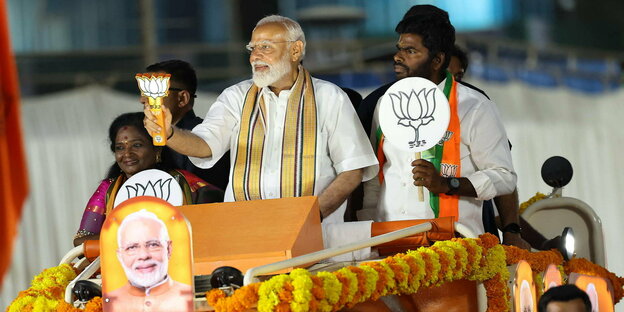Elections are being held in the world's largest democracy. The secular Indian republic is at stake; Prime Minister Modi dreams of a Hindu state.

Narendra Modi and his right-wing nationalist People's Party, the BJP, want to govern for the third consecutive time Photo: Seshadri Sukumar/imago
MUMBAI taz | Narendra Modi raises his hand to a cheering crowd in Chandrapur, western India, earlier this week. “These elections are a fight between stability and chaos,” proclaims the prime minister, dressed in bright colors. These are exhausting days for the 73-year-old: a new parliament will be elected in India in almost seven weeks from April 19.
960 million people have the right to vote and Modi is the favorite in countless settings, sometimes with temperatures exceeding 40 degrees. Despite rising unemployment and massive corruption under his rule, Modi's approval rating averaged 75 percent in February, according to an Ipsos poll — nearly 92 percent in the north and 35 percent in the south.
Narendra Modi and his right-wing nationalist People's Party, BJP, want to govern for the third time in a row. So far only the rival Congress Party (INC) has managed to do so. At the rally in Chandrapur, Modi described them as the “source of all the country's problems”.
His popularity gives Modi a comfortable advantage in the election campaign. This is necessary because his party has set a goal: it wants to have 400 of the 543 deputies in the lower house of parliament in the next legislature. Observers assume that Modi, with such great creative power, will in the long run steer secular India toward pro-Hinduism at the expense of minorities. Proof of this can be found in the BJP's election manifestos. And in recent history.
962 million eligible voters
The world's most important elections will take place from April 19 to June 1. In total, 497 million men and 471 million women have the right to vote; The number of registered women has increased over the years. This means that they have become the focus of attention of the parties as a target group. More than a fifth of voters are between 18 and 29 years old.
Complex logistics
Whether in the highlands, lowlands, river delta or remote villages, everyone should have access to a polling station within a two-kilometre radius. This is more than a challenge: Election Commission teams crossed jungles and snow-capped mountains, forded rivers in life jackets, walked for miles and transported voting computers on horseback and even on elephants, returning officer Rajiv Kumar said while announcing the schedule. electoral.
BJP paves way to Hindu nation
Five years ago, the BJP promised to build a temple in Ayodhya, northern India, in honor of the Hindu god Ram. At the site where a radical mob demolished the Babri mosque in 1992. The Vishwa Hindu Parishad, an organization associated with the BJP, had long mobilized against the Muslim place of worship. In January this year, the BJP fulfilled its promise with a pompous inauguration ceremony in Ayodhya.
It is another step towards becoming a Hindu nation in which Muslim and Christian influences are ruthlessly suppressed. In 2002, there was an anti-Muslim pogrom in Gujarat that left 2,000 dead. Although Modi, the state's then chief minister, was temporarily banned from entering the United States, this did not significantly damage his image in Indian society.
Modi presents himself as the man who made India great. He promises to advance the country economically and in international politics. To do this, he took advantage of the fact that India will host the G20 summit in 2023. The war in Ukraine and China's aggression also favor him.
Devang Dave has been active in Modi's party since his student days. “The BJP is an organized party, that is its strength,” the 34-year-old told taz. This makes them a “successful election campaign machine” throughout the country. For Dave, the BJP is also about the Hindutva ideology, which aims for a united Hindu nation. “Most people in the country believe in it,” says Dave, who, like Modi, has his roots in Gujarat, in the west of the country.
“Proud Hindus” vote for Narendra Modi

This article was made possible by the financial support of Forschungsfonds Ausland eV. You can support the research fund through a donation or membership.
➡ More information here
He also attributes the Prime Minister's popularity to the fact that “Modi has ensured that we express the pride of the country all over the world.” Since Modi came to power, the term “proud Hindu” has surfaced, especially on social media. This resonates in South India too, says Dave. The BJP wants to make progress there, in particular.
Narendra Damodardas Modi, of humble origins, has established himself as the “architect of the new India.” His father traded cooking oil in a small town in Gujarat. At the age of eight, Modi joined the Rashtriya Swayamsevak Sangh (RSS), an organization that seeks a Hindu nation and is the ideological backbone of the BJP.
Founded in 1925, the RSS left a lasting mark on Modi and paved its way to the BJP in 1987. In 2001, Modi replaced the ruling BJP chief in Gujarat and remained in that position until he was elected prime minister in 2014.
Political scientist Sumit Ganguly of Indiana University sees the success of the BJP as a failure of the old elite, especially the Congress Party. Under the leadership of the Nehru-Gandhi family, they have controlled the country's fortunes since independence in 1947, with the exception of 13 years.
Modi ran as an outsider in 2014 with a well-received anti-corruption campaign. He emphasized that he has no family who could benefit from his position. He dedicated his life to religion and nation. “Several factors influenced his victory. It was not Hindu nationalism,” says Ganguly. Back then the motto was: “Minimum government – maximum governance”, in 2019 it was “Modi makes it possible”. In 2024, the campaign slogan is simply: “The Modi Guarantee.”
Hindu nationalism and economic growth
Under Modi, the role of religion has become more important. He combines Hindu nationalism with economic modernization, something that part of the middle class values. With the success he had in Gujarat, he is promoting similar development across India. Gujarat's economy has grown under the Modi government. And India also experienced an economic rise during Modi's reign.
According to the World Bank, the country has become the second fastest growing G20 economy. The Indian stock index Sensex has hit a new all-time high.
Challenging climate
Added to this is the tropical climate. Elections usually take place during school holidays, which are among the hottest of the year. The months leading up to the rainy season are known for this, and there are already heat wave alerts. On the ground, this means that polling stations must be equipped with sufficient drinking water and shaded areas in case queues form.
Hand, lotus flower, elephant or broom.
Unlike the electoral process, the counting is done quickly: in India voting is done using electric machines with party symbols on the buttons. This means that even people who can't read can recognize their favorite match. The hand of the Congress Party or the lotus flower, which represents the BJP, are well known. Other symbols include a gas cylinder, a bicycle, an elephant, a hammer and sickle or a broom.
However, many of Modi's successes can be traced back to initiatives taken by his previous government. Furthermore, growth is not fair. Economists, including Thomas Piketty, show that inequality in the country is higher under the Modi government than during the British colonial era. The motto is: Little regulation that promotes the prosperity of a few.
Meanwhile, the electorate is polarizing along ethno-religious lines. French political scientist Christophe Jaffrelot speaks of India as an “ethnic democracy” that equates majority society with the nation and demeans religious minorities. “In the 20th century, Hindu nationalism was structured mainly in opposition to Islam,” says Christophe Jaffrelot.
Narendra Modi gave the BJP a new dimension in the 2000s: national populism. Talking about Modi's appeal, Jaffrelot says, “Like many populists, Modi is a chameleon, that's the trademark of him. “Everyone can find what they are looking for.” Furthermore, Modi and his party recognized the power of social media from the beginning. Modi has active profiles on Twitter, Facebook and Instagram with tens of millions of followers, his own app called NaMo and uses artificial intelligence to translate his voice into numerous Indian languages.
Meanwhile, freedoms in the country are being reduced: the Swedish research institute V-Dem now describes India as an “electoral autocracy”. The ruling party uses the UAPA anti-terrorism law to silence its critics. V-Dem also warns against government censorship that suppresses the right to religious freedom, political opponents and dissenting opinions.
Investigations against members of the opposition
Much of the Indian opposition has joined forces to form the National Inclusive Alliance for the Development of India, or India for short, to defend the secular idea of the Republic of India. But more powerful federal authorities are investigating many members of the opposition for financial crimes. “In this regard, Modi's assurance is that all opposition leaders will be in jail after June 4, when the general election results are known,” said Mamata Banerjee, chief minister of West Bengal state. Arvind Kejriwal, chief minister of Delhi, has been detained since March 21 on corruption charges.
Former party leader Sonia Gandhi complains that Modi is systematically trying to weaken the INC financially. Recently, tax authorities confiscated and frozen several party accounts. Opposition parties then filed complaints against the BJP and Modi with the Election Commission.
Rahul Gandhi, also former president of the Congress Party, said: “This election is a battle between two ideologies! On one side is the Congress, which has always united India, and on the other side are those who have always tried to divide the people.”
Gandhi initiated a nationwide “March for Indian Unity” in 2022, which continued from January to March. For many Indians, the prominent opposition politician, whose father, grandmother and great-grandfather were India's prime minister, is not an alternative to the up-and-coming Modi because of his background.
So far, the Indian bloc lacks strong candidates for the highest office. But the elections have not yet started and many farmers are more than disappointed by the empty promises of the current government.
